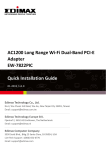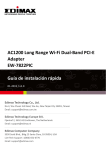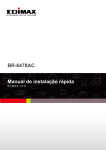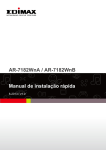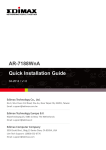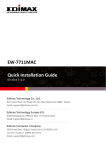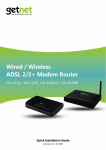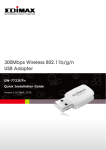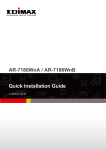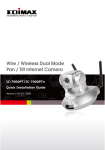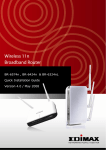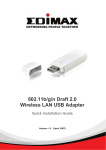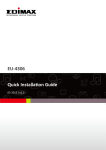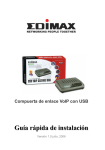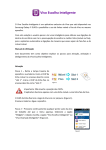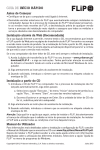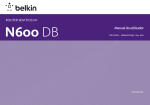Download AC1200 Long Range Wi-Fi Dual-Band PCI-E Adapter EW
Transcript
AC1200 Long Range Wi‐Fi Dual‐Band PCI‐E Adapter EW‐7822PIC Guia de instalação rápida 01‐2015 / v1.0 0 Índice I. Informações sobre o produto ..................................................... 1 I‐1. I‐2. I‐3. Conteúdo da embalagem ........................................................................................................ 1 Estado do LED .......................................................................................................................... 1 Requisitos do sistema .............................................................................................................. 1 II. Instalação do hardware .............................................................. 2 III. Assistente de configuração ......................................................... 4 III‐1. III‐2. III‐2‐1. III‐2‐2. Instalação do controlador ........................................................................................................ 4 Desinstalação do controlador .................................................................................................. 8 Windows XP/Vista/7 ................................................................................................................ 8 Windows 8/8.1 ......................................................................................................................... 8 IV. Utilizar o adaptador ................................................................... 9 V. Resolução de problemas ........................................................... 10 Multi‐Language Quick Installation Guide (QIG) on the CD Čeština: Českého průvodce rychlou instalací naleznete na přiloženém CD s ovladači. Deutsch: Finden Sie bitte das deutsche S.A.L. beiliegend in der Treiber CD. Español: Incluido en el CD el G.R.I. en Español. Français: Veuillez trouver l’français G.I.R ci‐joint dans le CD. Italiano: Incluso nel CD il Q.I.G. in Italiano. Magyar: A magyar telepítési útmutató megtalálható a mellékelt CD‐n. Nederlands: De nederlandse Q.I.G. treft u aan op de bijgesloten CD. Polski: Skrócona instrukcja instalacji w języku polskim znajduje się na załączonej płycie CD. Português: Incluído no CD o G.I.R. em Portugues. Русский: Найдите Q.I.G. на pусскoм языке на приложеном CD. Türkçe: Ürün ile beraber gelen CD içinde Türkçe Hızlı Kurulum Kılavuzu'nu bulabilirsiniz. Українська: Для швидкого налаштування Вашого пристрою, будь ласка, ознайомтесь з інструкцією на CD. Romȃnă: Ghid de instalare Rapidă ȋn limba Romȃnă ȋn interiorul CD‐ului. I. Informações sobre o produto O EW‐7822PIC é um adaptador Wi‐Fi PCIe, banda dupla, 11ac de 2,4 GHz e 5 GHz para computadores de secretária. I‐1. Conteúdo da embalagem Base da antena EW‐7822PIC Antenas x 2 QIG CD‐ROM Suporte discreto I‐2. Estado do LED Estado Intermitente Descrição Actividade de Wi‐Fi: a transferir ou receber dados. I‐3. Requisitos do sistema ‐ ‐ ‐ ‐ Windows XP/Vista/7/8/8.1 Disco rígido: 100MB Unidade de CD‐ROM Ranhura de PCIe não ocupada 1 II. Instalação do hardware 1. Desligue ou retire o computador e retire a tampa. Consulte o manual do utilizador do computador se não tiver a certeza como deve retirar a tampa e localizar uma ranhura de PCIe. 2. Insira a placa de rede sem fios numa ranhura de PCIe não ocupada. A embalagem inclui também um suporte PCIe discreto. 2 3. Volte a instalar a tampa no computador e aparafuse as antenas incluídas directamente na placa de rede sem fios ou utilize a base da antena fornecida. 4. Se necessário, pode ajustar a posição da(s) antena(s) para usufruir de uma melhor recepção sem fios. 3 III. Assistente de configuração III‐1. Instalação do controlador 1. Ligue o computador. Se o assistente do Windows “Found New Hardware” (Novo hardware encontrado) for apresentado, feche‐o. 2. Insira o CD‐ROM incluído na unidade de CD do computador. O assistente de configuração também está disponível para transferência no Website da Edimax. 3. O assistente de configuração é apresentado, como indicado abaixo. Clique no adaptador PCIe sem para continuar. Se o CD não for executado automaticamente ou se transferiu o assistente de configuração, vá para a pasta “Autorun” (Execução automática) no CD. 4 4. Clique em “Install Driver” (Instalar controlador) para continuar a instalar os controladores do modelo EW‐7822PIC. 5 5. Aguarde enquanto o assistente de configuração prepara a instalação dos controladores. 6. Clique em “Next” (Seguinte) para instalar o controlador. 6 7. Aguarde até o controlador estar instalado. 8. Quando a instalação estiver concluída, seleccione se pretende reiniciar o computador agora ou mais tarde e clique em “Finish” (Terminar). 9. Depois de reiniciar, não pode estabelecer ligação a uma rede Wi‐Fi disponível, como habitual. Para saber como fazê‐lo, consulte IV. Utilizar o adaptador. 7 III‐2. Desinstalação do controlador III‐2‐1. Windows XP/Vista/7 1. Vá para Start > Programs > Edimax Wireless LAN > Uninstall (Iniciar > Programas > Rede local sem fios da Edimax > Desinstalar). 2. Siga as instruções no ecrã. O assistente de desinstalação irá orientá‐lo durante o processo. III‐2‐2. Windows 8/8.1 1. Clique em qualquer local no ecrã “Start” (Iniciar) e, em seguida, clique no ícone “All apps” (Todas as aplicações) no canto inferior direito. 2. Localize a categoria Edimax Wireless LAN (Rede local sem fios da Edimax), seleccione “Uninstall” (Desinstalar) e siga as instruções apresentadas no ecrã. 8 IV. Utilizar o adaptador Depois de instalar o controlador, pode estabelecer ligação a uma rede Wi‐Fi como habitual. Segue‐se abaixo um exemplo de como estabelecer ligação utilizando o Windows Vista ‐ o processo pode variar ligeiramente de outras versões do Windows. 1. Clique no ícone de rede (os exemplos são mostrados abaixo) no tabuleiro do sistema e seleccione “Connect to a network” (Ligar a uma rede). 2.Procure o SSID da sua rede Wi‐Fi e, em seguida, clique em “Connect” (Ligar). Se especificar uma palavra‐passe para a sua rede, ser‐lhe‐á solicitado para introduzi‐la. 3. Depois de introduzir a palavra‐passe correctamente, terá acesso à sua rede Wi‐Fi. 9 V. Resolução de problemas 1. A minha velocidade Wi‐Fi parece lenta ou não atinge velocidades de 802.11ac. a. Para usufruir de velocidades Wi‐Fi de 802.11ac, é necessário estabelecer ligação a um router Wi‐Fi 802.11ac. b. Pode estar a utilizar a velocidade da Internet e não a sua velocidade de rede local. As velocidades de Internet são limitadas pela largura de banda da Internet prestada pelo seu fornecedor de serviços. Websites como www.speed test.net testam a velocidade da Internet e não a velocidade da sua rede interna. A transferência de ficheiros entre dois computadores locais permite‐lhe conhecer a sua velocidade de rede. c. Verifique se as antenas estão fixadas nas portas ou na base da antena. Coloque a base da antena num local com menos obstruções ou coloque as antenas em ângulo para usufruir de um melhor desempenho. 2. Inseri o adaptador PCIe e instalei os controladores, mas não consigo estabelecer ligação a qualquer rede Wi‐Fi. a. Vá para o painel de controlo e desinstale o controlador EW‐7822PIC. Verifique se todos os programas anti‐vírus estão desactivados. Em seguida, instale de novo o controlador EW7822PIC. 10 COPYRIGHT Copyright © Edimax Technology Co., Ltd. all rights reserved. No part of this publication may be reproduced, transmitted, transcribed, stored in a retrieval system, or translated into any language or computer language, in any form or by any means, electronic, mechanical, magnetic, optical, chemical, manual or otherwise, without the prior written permission from Edimax Technology Co., Ltd. Edimax Technology Co., Ltd. makes no representations or warranties, either expressed or implied, with respect to the contents hereof and specifically disclaims any warranties, merchantability, or fitness for any particular purpose. Any software described in this manual is sold or licensed as is. Should the programs prove defective following their purchase, the buyer (and not this company, its distributor, or its dealer) assumes the entire cost of all necessary servicing, repair, and any incidental or consequential damages resulting from any defect in the software. Edimax Technology Co., Ltd. reserves the right to revise this publication and to make changes from time to time in the contents hereof without the obligation to notify any person of such revision or changes. The product you have purchased and the setup screen may appear slightly different from those shown in this QIG. The software and specifications are subject to change without notice. Please visit our website www.edimax.com for updates. All brand and product names mentioned in this manual are trademarks and/or registered trademarks of their respective holders. Federal Communication Commission Interference Statement This equipment has been tested and found to comply with the limits for a Class B digital device, pursuant to Part 15 of FCC Rules. These limits are designed to provide reasonable protection against harmful interference in a residential installation. This equipment generates, uses, and can radiate radio frequency energy and, if not installed and used in accordance with the instructions, may cause harmful interference to radio communications. However, there is no guarantee that interference will not occur in a particular installation. If this equipment does cause harmful interference to radio or television reception, which can be determined by turning the equipment off and on, the user is encouraged to try to correct the interference by one or more of the following measures: 1. Reorient or relocate the receiving antenna. 2. Increase the separation between the equipment and receiver. 3. Connect the equipment into an outlet on a circuit different from that to which the receiver is connected. 4. Consult the dealer or an experienced radio technician for help. FCC Caution This device and its antenna must not be co‐located or operating in conjunction with any other antenna or transmitter. This device complies with Part 15 of the FCC Rules. Operation is subject to the following two conditions: (1) this device may not cause harmful interference, and (2) this device must accept any interference received, including interference that may cause undesired operation. Any changes or modifications not expressly approved by the party responsible for compliance could void the authority to operate equipment. Federal Communications Commission (FCC) Radiation Exposure Statement This equipment complies with FCC radiation exposure set forth for an uncontrolled environment. In order to avoid the possibility of exceeding the FCC radio frequency exposure limits, human proximity to the antenna shall not be less than 2.5cm (1 inch) during normal operation. Federal Communications Commission (FCC) RF Exposure Requirements This EUT is compliance with SAR for general population/uncontrolled exposure limits in ANSI/IEEE C95.1‐1999 and had been tested in accordance with the measurement methods and procedures specified in OET Bulletin 65 Supplement C. The equipment version marketed in US is restricted to usage of the channels 1‐11 only. This equipment is restricted to indoor use when operated in the 5.15 to 5.25 GHz frequency range. R&TTE Compliance Statement This equipment complies with all the requirements of DIRECTIVE 1999/5/EC OF THE EUROPEAN PARLIAMENT AND THE COUNCIL of March 9, 1999 on radio equipment and telecommunication terminal equipment and the mutual recognition of their conformity (R&TTE). The R&TTE Directive repeals and replaces in the directive 98/13/EEC (Telecommunications Terminal Equipment and Satellite Earth Station Equipment) As of April 8, 2000. Safety This equipment is designed with the utmost care for the safety of those who install and use it. However, special attention must be paid to the dangers of electric shock and static electricity when working with electrical equipment. All guidelines of this and of the computer manufacture must therefore be allowed at all times to ensure the safe use of the equipment. EU Countries Intended for Use The ETSI version of this device is intended for home and office use in Austria, Belgium, Bulgaria, Cyprus, Czech, Denmark, Estonia, Finland, France, Germany, Greece, Hungary, Ireland, Italy, Latvia, Lithuania, Luxembourg, Malta, Netherlands, Poland, Portugal, Romania, Slovakia, Slovenia, Spain, Sweden, Turkey, and United Kingdom. The ETSI version of this device is also authorized for use in EFTA member states: Iceland, Liechtenstein, Norway, and Switzerland. EU Countries Not Intended for Use None. EU Declaration of Conformity English: This equipment is in compliance with the essential requirements and other relevant provisions of Directive 1999/5/EC, 2009/125/EC. Français: Cet équipement est conforme aux exigences essentielles et autres dispositions de la directive 1999/5/CE, 2009/125/CE. Čeština: Toto zařízení je v souladu se základními požadavky a ostatními příslušnými ustanoveními směrnic 1999/5/ES, 2009/125/ES. Polski: Urządzenie jest zgodne z ogólnymi wymaganiami oraz szczególnymi warunkami określonymi Dyrektywą UE 1999/5/EC, 2009/125/EC. Română: Acest echipament este în conformitate cu cerințele esențiale şi alte prevederi relevante ale Directivei 1999/5/CE, 2009/125/CE. Русский: Это оборудование соответствует основным требованиям и положениям Директивы 1999/5/EC, 2009/125/EC. Magyar: Ez a berendezés megfelel az alapvető követelményeknek és más vonatkozó irányelveknek (1999/5/EK, 2009/125/EC). Türkçe: Bu cihaz 1999/5/EC, 2009/125/EC direktifleri zorunlu istekler ve diğer hükümlerle ile uyumludur. Українська: Обладнання відповідає вимогам і умовам директиви 1999/5/EC, 2009/125/EC. Slovenčina: Toto zariadenie spĺňa základné požiadavky a ďalšie príslušné ustanovenia smerníc 1999/5/ES, 2009/125/ES. Deutsch: Dieses Gerät erfüllt die Voraussetzungen gemäß den Richtlinien 1999/5/EC, 2009/125/EC. Español: El presente equipo cumple los requisitos esenciales de la Directiva 1999/5/EC, 2009/125/EC. Italiano: Questo apparecchio è conforme ai requisiti essenziali e alle altre disposizioni applicabili della Direttiva 1999/5/CE, 2009/125/CE. Nederlands: Dit apparaat voldoet aan de essentiële eisen en andere van toepassing zijnde bepalingen van richtlijn 1999/5/EC, 2009/125/EC. Português: Este equipamento cumpre os requesitos essênciais da Directiva 1999/5/EC, 2009/125/EC. Norsk: Dette utstyret er i samsvar med de viktigste kravene og andre relevante regler i Direktiv 1999/5/EC, 2009/125/EC. Svenska: Denna utrustning är i överensstämmelse med de väsentliga kraven och övriga relevanta bestämmelser i direktiv 1999/5/EG, 2009/125/EG. Dansk: Dette udstyr er i overensstemmelse med de væsentligste krav og andre relevante forordninger i direktiv 1999/5/EC, 2009/125/EC. Suomi: Tämä laite täyttää direktiivien 1999/5/EY, 2009/125/EY oleelliset vaatimukset ja muut asiaankuuluvat määräykset. ‐‐‐‐‐‐‐‐‐‐‐‐‐‐‐‐‐‐‐‐‐‐‐‐‐‐‐‐‐‐‐‐‐‐‐‐‐‐‐‐‐‐‐‐‐‐‐‐‐‐‐‐‐‐‐‐‐‐‐‐‐‐‐‐‐‐‐‐‐‐‐‐‐‐‐‐‐‐‐‐‐‐‐‐‐‐‐‐‐‐‐‐‐‐‐‐‐‐‐‐‐‐‐‐‐‐‐‐‐‐‐‐‐‐‐‐‐‐‐ WEEE Directive & Product Disposal At the end of its serviceable life, this product should not be treated as household or general waste. It should be handed over to the applicable collection point for the recycling of electrical and electronic equipment, or returned to the supplier for disposal. Declaration of Conformity We, Edimax Technology Co., Ltd., declare under our sole responsibility, that the equipment described below complies with the requirements of the European R&TTE directives. Equipment: AC1200 Long Range Wi‐Fi Dual‐Band PCI Express Adapter Model No.: EW‐7822PIC The following European standards for essential requirements have been followed: Directives 1999/5/EC Spectrum : EMC : Safety (LVD) : ETSI EN 300 328 V1.8.1 (2012-06); ETSI EN 301 893 V1.7.1 (2012-06) EN 301 489-1 V1.9.2 (2011); EN 301 489-17 V2.2.1 (2012) EN 60950-1:2006+A11:2009+A1:2010+A12:2011 Directives 2006/95/EC Safety (LVD) : EN 60950-1:2006+A11:2009+A1:2010+A12:2011 Edimax Technology Co., Ltd. No. 3, Wu Chuan 3rd Road, Wu‐Ku Industrial Park, New Taipei City, Taiwan Date of Signature: February, 2015 Signature: Printed Name: Title: Albert Chang Director Edimax Technology Co., Ltd.


















